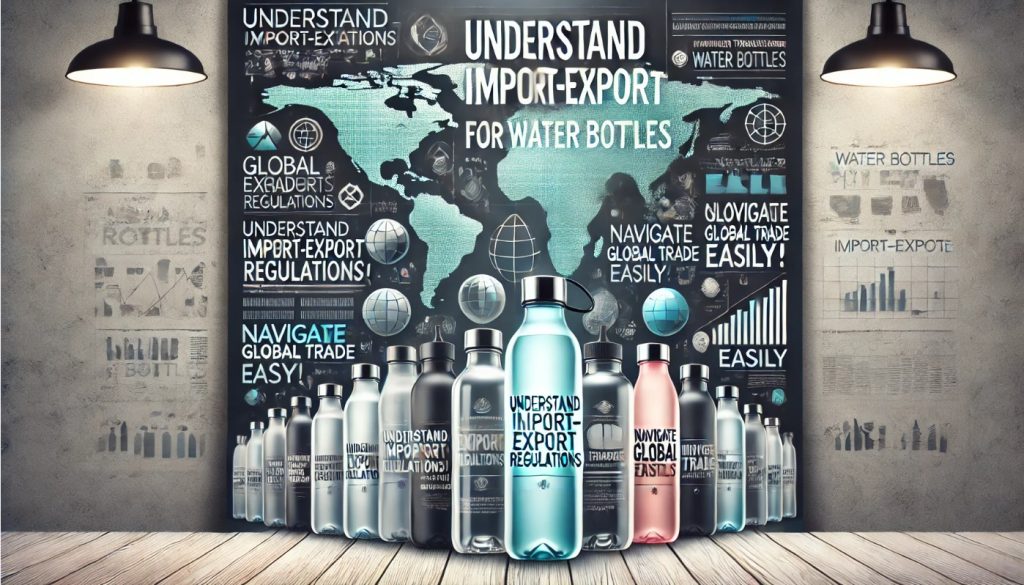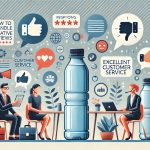The global market for water bottles continues to expand as consumers demand more sustainable, functional, and aesthetically appealing products. As water bottle businesses seek to grow internationally, navigating import and export regulations becomes essential for success. These regulations govern how products move across borders and ensure that they meet safety, quality, and environmental standards. Water bottle manufacturers, retailers, and distributors must be well-versed in these regulations to avoid costly delays, fines, and legal complications.
In the context of water bottles, there are various factors to consider when engaging in international trade. From product certifications to environmental standards and packaging requirements, the complexities of import and export regulations can vary significantly depending on the destination country or region.
The Basics of Import and Export Regulations
What Are Import and Export Regulations?
Import and export regulations refer to the set of rules and laws that govern the movement of goods across international borders. These regulations are set by individual countries or regions to ensure that imported and exported products meet specific standards for safety, quality, and environmental impact. They also address tariff classifications, customs procedures, and documentation requirements.
For businesses involved in the water bottle industry, understanding these regulations is crucial for ensuring that products can be legally imported and exported without delays or issues. Failure to comply with these regulations can result in products being held at customs, fines, or even the denial of entry into certain markets.
Key Areas of Import/Export Regulations
Import/export regulations encompass various areas that water bottle businesses must address. Some of the primary areas include:
- Product Certification and Compliance: Regulations around product safety, materials, and manufacturing standards.
- Customs Procedures: The process of clearing goods through customs, including tariffs, taxes, and paperwork.
- Environmental Standards: Regulations that focus on the sustainability and recyclability of materials used in products and packaging.
- Labeling and Packaging: Specific requirements for product labeling and packaging to comply with local laws.
- Intellectual Property (IP) and Trade Agreements: Protection of intellectual property rights and the role of international trade agreements in facilitating or restricting trade.
Product Safety and Quality Certifications
Regulatory Agencies and Certification Bodies
Water bottles are considered consumer goods, which means they must comply with various safety and quality regulations to ensure they are safe for use. Different countries have regulatory bodies responsible for overseeing these standards and certifying products for import/export. Some of the most well-known agencies include:
- U.S. Food and Drug Administration (FDA): In the United States, the FDA regulates water bottles that come into contact with food and beverages. They ensure that water bottles are free from harmful substances, such as Bisphenol A (BPA), and that they meet health and safety standards for consumer use.
- European Food Safety Authority (EFSA): In the European Union, EFSA oversees regulations related to food safety, including materials that come into contact with food, like water bottles. They provide guidelines on materials, substances, and production processes that ensure products are safe for consumers.
- National Standardization Agencies: Many countries have their own national certification bodies. For example, China has the China National Institute of Standardization (CNIS), and India follows the Bureau of Indian Standards (BIS) for certain types of consumer products.
Certification is essential to ensuring that a product meets all required health, safety, and quality standards. For water bottles, this typically involves ensuring that the product is made from non-toxic, food-safe materials and that it does not leach harmful chemicals.
Product Testing and Safety Standards
Product safety is critical for water bottles, as these items come into direct contact with drinking water or beverages. Countries have set specific standards for testing materials used in the production of water bottles. For example, bottles made from plastics must pass tests that check for leaching of harmful substances such as BPA, phthalates, or other toxic chemicals.
In the European Union, the European Commission has established specific regulations for materials that come into contact with food. Regulation (EC) No 1935/2004 outlines the general safety of food contact materials, and manufacturers must ensure that their products comply with these standards before exporting. Similar regulations exist in many countries, and compliance is essential for avoiding issues at customs.
Water bottles made from stainless steel, glass, or aluminum must also adhere to product safety regulations. Stainless steel bottles, for instance, need to meet specific standards for corrosion resistance and ensure that no harmful materials are present in the metal composition.
Eco-Friendly Certifications and Standards
As sustainability becomes an increasing priority for consumers, many countries have established environmental regulations concerning the recyclability and sustainability of products. Water bottle businesses that aim to export their products need to ensure they meet local environmental standards.
For example, products that claim to be “BPA-free” or “eco-friendly” must often be backed by certification. Common certifications include the Recycling Symbol, Green Seal, or ISO 14001 (Environmental Management Systems), which certify that products and production processes comply with sustainable practices. Businesses should also consider complying with local recycling and disposal regulations when exporting water bottles to countries with stringent environmental laws.
Customs Procedures and Documentation
Tariffs and Taxes
When exporting water bottles internationally, businesses must be aware of tariffs and taxes imposed by customs authorities. Tariffs are duties or taxes that are levied on imported goods, and they can vary significantly depending on the destination country. For water bottles, tariffs typically depend on the material, classification of the product, and country of origin.
For example, in the United States, the tariff rates on water bottles can differ based on whether the bottles are made from plastic, stainless steel, or glass. Understanding these rates and accounting for them in pricing strategies is essential for ensuring competitiveness in international markets.
Many countries are party to international trade agreements, such as the North American Free Trade Agreement (NAFTA) or the European Union Customs Union, which may reduce or eliminate tariffs on certain goods. Water bottle businesses should familiarize themselves with these trade agreements to take advantage of preferential tariff rates.
Customs Documentation and Compliance
Successfully navigating customs involves completing the necessary paperwork and providing accurate documentation. Common documents required for water bottle exports include:
- Commercial Invoice: A detailed invoice listing the products, their value, and the terms of sale. This document is essential for customs clearance.
- Packing List: A list that outlines the contents, dimensions, and weight of the shipment, ensuring that goods are properly accounted for during transit.
- Certificate of Origin: A document that certifies the country of origin of the goods, which may be required for certain trade agreements or preferential tariff treatment.
- Bill of Lading: A shipping document that provides proof of the contract between the seller and the carrier.
Failure to complete these documents accurately can lead to delays, fines, or even the seizure of goods by customs authorities. Water bottle businesses should work with experienced freight forwarders or customs brokers to ensure that all necessary paperwork is correctly filed.
Customs Inspections and Delays
Goods entering a country may be subject to customs inspection. Customs authorities may inspect the shipment to ensure that it complies with safety, quality, and environmental regulations. Delays in customs inspections can affect the timely delivery of products and disrupt supply chains, especially when dealing with high-demand products like water bottles.
Businesses should factor in potential delays when planning international shipments and be prepared for customs procedures to take longer than expected. Building relationships with reliable suppliers and freight forwarders who have experience with international shipping can help expedite the customs process.
Labeling and Packaging Requirements
Labeling Standards
Labeling requirements for water bottles can vary widely by country, depending on consumer protection laws, environmental regulations, and health standards. Water bottles must have clear and accurate labeling that meets local regulations in each market. Key labeling considerations include:
- Material Composition: Labels must indicate the materials used in the water bottle (e.g., stainless steel, glass, BPA-free plastic) to inform consumers about the safety of the product.
- Certifications: Water bottles may need to display certain certifications, such as “BPA-free” or “recyclable,” depending on local laws.
- Usage Instructions: Many countries require specific instructions on how to use the product, such as washing and care instructions, especially for reusable water bottles.
- Language Requirements: Labels often need to be printed in the local language(s) of the destination market. For example, if a water bottle is being exported to France, the label must be in French, and the relevant safety information must be provided in the language.
Non-compliance with local labeling regulations can result in fines, product recalls, or the rejection of goods at customs. Companies should ensure that they familiarize themselves with the labeling requirements for each target market.
Packaging Regulations
Packaging is another area where import/export regulations come into play. Many countries have regulations regarding the materials used in packaging, especially concerning sustainability and recyclability. For example, the European Union has stringent rules around packaging waste, requiring businesses to ensure that packaging materials are recyclable or made from sustainable materials.
In addition to environmental considerations, packaging must also meet safety standards. For water bottles, packaging must protect the product during transport, preventing damage, contamination, or leakage. Companies must also consider the potential impact of packaging on customs duties, as some types of packaging may increase the overall weight or volume of the shipment, affecting shipping costs.
Environmental and Sustainability Regulations
Single-Use Plastic Bans
As part of global efforts to reduce plastic waste, many countries are implementing stricter regulations around single-use plastics. This has significant implications for the water bottle market, as many traditional water bottles are made from plastic. For instance, the European Union introduced a directive in 2019 that bans certain single-use plastic items, including plastic bottles, by 2025, requiring businesses to switch to more sustainable materials like glass or stainless steel.
Water bottle companies must stay informed about regional regulations and adapt their products accordingly. Companies that offer sustainable alternatives, such as bottles made from stainless steel, glass, or biodegradable plastics, are likely to be well-positioned to meet these evolving standards.
Extended Producer Responsibility (EPR)
Extended Producer Responsibility (EPR) is a regulatory framework that holds manufacturers accountable for the entire lifecycle of their products, including post-consumer waste management. EPR regulations may require water bottle brands to take responsibility for the recycling or disposal of their products after they have been used by consumers.
This regulation is becoming more common in markets like Europe and is expanding in other regions. Water bottle brands may need to pay fees or implement programs to ensure their products are collected and recycled properly. Companies that actively engage in sustainable practices and align their business model with EPR principles can gain a competitive edge in markets that prioritize environmental responsibility.
International Trade Agreements and Tariffs
Free Trade Agreements (FTAs)
Free Trade Agreements (FTAs) are designed to reduce or eliminate tariffs and trade barriers between participating countries. FTAs can play a significant role in facilitating the import/export of water bottles, especially when it comes to reducing costs and improving market access.
For example, the United States-Mexico-Canada Agreement (USMCA) facilitates trade between North America’s three largest economies by reducing tariffs and easing restrictions. Similarly, the Comprehensive and Progressive Agreement for Trans-Pacific Partnership (CPTPP) helps streamline trade between 11 countries across the Pacific Rim, offering water bottle brands greater access to Asian markets.
Understanding and leveraging FTAs is essential for water bottle brands looking to expand internationally. These agreements can provide reduced shipping costs, preferential tariffs, and more efficient trade routes.
Impact of Tariffs and Non-Tariff Barriers
While FTAs can help reduce tariffs, water bottle businesses should still be aware of non-tariff barriers (NTBs) that may impact international trade. NTBs can include quotas, licensing requirements, subsidies, or even standards that restrict the flow of goods. For example, a country may require that water bottles be tested for safety before they are allowed to enter the market or may impose restrictions on certain materials used in the production of bottles.
By staying informed about international trade policies, water bottle brands can better navigate the complexities of tariffs and non-tariff barriers and plan their export strategies accordingly.
Conclusion
Import and export regulations are an essential aspect of global trade for water bottle businesses. Navigating the complexities of product certifications, customs procedures, labeling requirements, and environmental standards is critical for successfully entering and expanding in international markets. Water bottle brands must remain diligent in understanding the regulations of each target market and ensure compliance to avoid delays, fines, or reputational damage. By keeping up with evolving regulations and leveraging international trade agreements, businesses can expand their reach, cater to eco-conscious consumers, and drive growth in a global marketplace.







